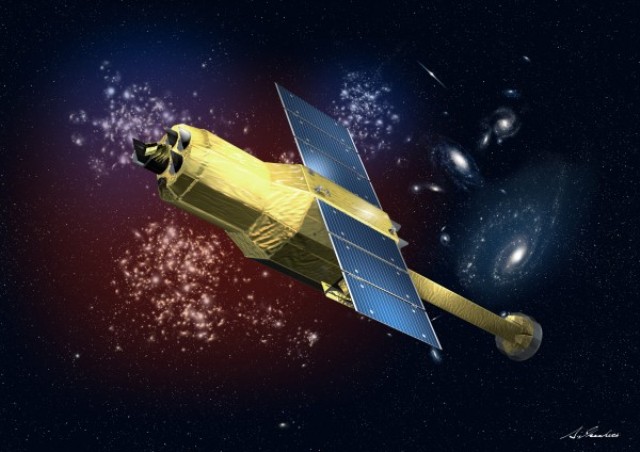Feb 12 2016
A University of Southampton researcher will explore the structure and evolution of the Universe, as part of the ASTRO-H X-ray space telescope mission being launched in Japan this week.
 Artist’s impression of the ASTRO-H observatory (credit: Akihiro Ikeshita / JAXA).
Artist’s impression of the ASTRO-H observatory (credit: Akihiro Ikeshita / JAXA).
Dr Poshak Gandhi, Associate Professor and STFC Ernest Rutherford Fellow in the University’s Astronomy Group, is one of over 200 astronomers from over 60 contributing institutions in Japan, the US, Canada and Europe involved in the major international collaboration. It is led by the Japan Aerospace Exploration Agency (JAXA) and also includes NASA and the European Space Agency (ESA).
The aim of the new satellite is to study hot and extremely dense objects in the universe, such as black holes and clusters of galaxies. Most of the largest, growing black holes are hidden behind thick interstellar gas and dust clouds and using X-ray observations is the only way researchers can directly study many of them. ASTRO-H will enable better X-ray spectroscopy of black holes than ever before.
Dr Gandhi says: “This new space telescope represents the culmination of decades of research and development into space X-ray detector technologies led by Japan, but the scientific challenges that ASTRO-H will tackle require the combined expertise of astronomers the world over. I am very excited to be part of this international collaborative effort, and look forward to solving mysteries that have long puzzled us.”
Professor Tadayuki Takahashi, from the Institute of Space and Astronautical Science and ASTRO-H Project Director, says: “Black holes were first identified in space over 40 years ago, but we are still far from understanding how they grow and evolve. The high precision ‘X-ray colour vision’ of ASTRO-H will be a huge step forward for such studies, and for understanding other hot and extreme objects in the universe.”
Dr Gandhi has been a member of the ASTRO-H mission since 2010. He will participate in two ‘science task forces’, focused on understanding how black holes accrete matter from their surroundings and grow, and to study the interaction between black holes and the galaxies in which they live.
Dr Gandhi adds: “One part of research focus at Southampton is the study of growing supermassive black holes at the centres of nearby galaxies. As Superman’s X-ray vision allows him to peer through walls, so ASTRO-H’s X-ray vision will be able to penetrate the veiling clouds surrounding black holes and will also be sensitive to any light reflected and scattered by these clouds.
“This, in turn, will allow us to determine all kinds of important properties of the interstellar clouds and the black holes that are hidden within them, including how powerful the black holes are, how much matter there is in the veiling clouds, and what kind of motion the clouds have. This will give us important insight into the growth of these black holes and their interaction with the large scale galaxy.”
ASTRO-H is equipped with four state-of-the-art instruments:
- Hard X-ray imaging system - consists of a Hard X-ray Telescope (HXT) and Hard X-ray Imager (HXI).
- Soft X-ray imaging system – consists of an imaging mirror, Soft X-ray Telescope (SXT-I) and Soft X-ray Imager (SXI).
- Soft X-ray Spectroscopy System - consists of the Soft X-ray Telescope (SXT-S), the Soft X-ray Spectrometer (SXS) and the cooling system.
- Soft Gamma-ray Detector (SGD)
These technologies will allow ASTRO-H to split X-ray light into its component colours, similar to a prism with sunlight. This will be achieved by detecting miniscule heat changes generated by individual incoming X-ray photons. This will enable measurement of the energies of X-ray photons to better precision (at least six times better) than any other satellite and allow researchers to distinguish many more ‘shades’ of X-ray colours than has been possible before. By analysing the X-ray energies, researchers will be able to determine the elemental composition, dynamical state and temperature of matter in these extreme and hot objects.
ASTRO-H will be launched into low-Earth orbit from the Tanegashima Space Center, Japan, by a JAXA H-IIA rocket on 12 February 2016. The mission will last for three years and ASTRO-H observing time will be available for any scientist across the world through a competitive, peer-reviewed proposal process.
It is the sixth satellite in a series of highly successful X-ray astronomy missions initiated by the Institute of Space and Astronautical Science (ISAS) of JAXA.